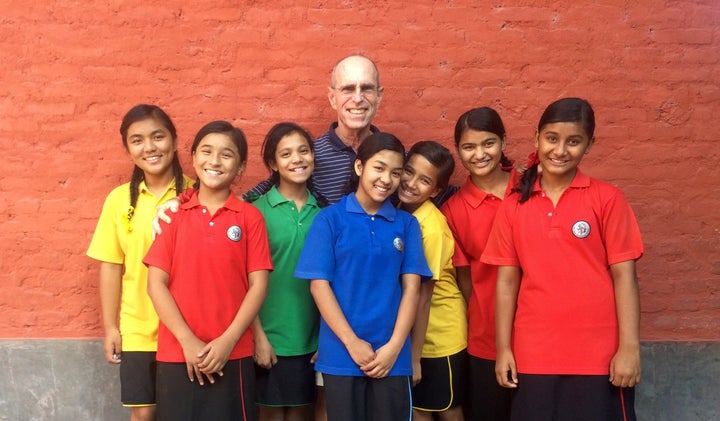
In May 1999, Bruce Keenan, CEO of a successful information technology business in Atlanta, was asked by a few friends to join them for a three-week trek in the mountains of Nepal. Bruce, 46 at the time, and ready for a break from the world of 9-5, bought himself a back pack, some hiking shoes, and a round trip ticket to Kathmandu – ready, as he is fond of saying, “for an adventure of a lifetime.” And indeed, it was, but not in the way he expected.
Two weeks into the trip, while staying at a roadside hotel in the Mustang district of northern Nepal, Bruce noticed a small, sad looking girl sweeping the floor outside his room. When he asked the hotel owner why the girl wasn’t in school, he received an answer that would change his life forever. “I found her wandering in the village,” the owner said. “She had been abandoned by her parents, so I took her in and paid for her schooling.”
But now, two years later, it was time for the girl to “pay for her keep” explained the hotel owner. Her age? Seven.
At that precise moment in time, 8,132 miles from home, Bruce had an epiphany – an “aha” that would change his life forever – and thankfully, in the years to come, the lives of hundreds of Nepalese orphans. Bruce knew, as he watched that seven-year old girl sweep the floor, that his real work in the world was inextricably linked to the 140 million orphans on planet Earth – and, for starters the orphans of Nepal.
Bruce’s first instincts, like anyone new to the world of orphans, was a predictable one – to fund the girl’s schooling in the village where she lived. It made perfect sense. But while his decision certainly seemed like a benevolent act, it would also, Bruce soon learned, become problematic – since the remoteness of the village would have made it impossible for him to maintain enough regular contact to ensure that the funds he provided were properly used. That would be Lesson #1 in a long line of lessons Bruce would learn in the coming years – that the “orphan situation” (in Nepal and, indeed, around the world) was not always what it seemed and that providing real, sustainable help would require the kind of due diligence that well-meaning do-gooders and eco-tourists weren’t always knowledgeable about.
Lesson #2? That if Bruce really wanted to make a difference he needed to do three things: 1) Get educated about the worldwide orphan situation; 2) Start his own non-profit in the USA (The Himalayan Children’s Charities) so he could be confident that his 40+ hours per week (and those of his wife and volunteers) would have maximum impact and; 3) Think long-term, so his orphan advocacy efforts went beyond merely providing food and clothing for children in need.
And so, if YOU, dear HuffPost reader, are moved to help improve the lives of the 140 million orphans in the world, but are stuck in the mud about how to make a difference without wasting your time or money, here is a simple guide for getting started – Bruce Keenan’s top ten guidelines – based on his 30 visits to Nepal and 18 years of full-time effort as an advocate and mentor for hundreds of children with no place to call home.
1. CONNECT WITH FRIENDS: Talk with people you trust who have been involved in efforts to support non-profit orphan charities. Get their input. Pick their brain. Learn from their experience. If they’ve made mistakes, find out what they were. And if they have discovered ways to participate that have made a difference, emulate them.
2. STUDY NON-PROFIT WEBSITES: You can learn a lot about a non-profit from their website. Read the bios of their Founders and staff. Note their accomplishments. Read case studies. Understand the scope of their services. Find out what percentage of donations goes to “administration.”
3. REVIEW GUIDESTAR.ORG: Always be mindful of the fact that some less-than-reputable charities exist in the world. A quick visit to Guidestar.org, an organization that certifies and evaluates charities, is a good place to begin your research. If the charity you are thinking of supporting is not listed in this guide, think twice about giving your support.
4. MEET THE FOUNDERS: Time and budget allowing, find a way to connect with the Founders or Program Directors of the non-profit you are thinking of supporting. In person, of course, is best. Phone or Skype is second best. But before you make contact, prepare a list of your questions and don’t be shy to ask. If the answers to your questions raise any red flags, double down and get your questions answered – or move on.
5. CHECK GOVERNMENT CERTIFICATION AS A NONPROFIT (501c3 in the US). The 501c3 status is a US government requirement for donations to be deductible on your IRS returns. Non-profits outside of the United States will not have this designation, but should have some kind of government approval as a non-profit. Regardless of the non-profit’s country of origin, its status as a non-profit should be posted on their web site.
6. REVIEW IRS 990s FOR US-BASED CHARITIES: While most charities in service to orphans are legitimate, there are always some whose only mission is to support their so-called Founders. If the Founders are receiving a salary, check to see if it is comparable to similar positions, in other US-certified 501c3s. The best way to protect yourself from less-than-reputable organizations is to review their financials. If their financials are not posted on their website, find out why and ask for them. (Here is an example of the kind of financials you will be reviewing). NOTE: IRS 990s are required for all non-profits in the United States. Foreign non-profits will not have 990s, but should still post their financials on their web sites.
7. GET FAMILIAR WITH THE VARIETIES OF “ORPHAN CATEGORIES”: Most people assume that orphans are children with no parents. This is not always true. There are also orphans with one parent (and sometimes two), but parents, for whatever reason, who are unable to care for their children. My wife’s parents, for example, were both orphans in France, but only because their parents were too poor to take care of them.
8. VOLUNTEER: While all non-profit orphan charities need financial support, it is not the only way to help. Many of these organizations offer a wide variety of other ways to participate in their work – most of which can be done from remote locations. Usually these options will be described on their websites. But be careful. Keep your eyes open. Some orphanages look attractive, on the outside, to well meaning volunteers, but the motivation for their existence may not be on the up and up. More about volunteering scams.
9. INVOLVE OTHER FAMILY MEMBERS: If you are married and/or have children, consider inviting the whole kit and caboodle to get involved with your orphan-support efforts. Serving on the front lines of social change is a great way for families to take their relationship to the next level.
10. TRACK PROGRESS: If, after considering all of the above, you choose to support a non-profit orphan charity, be clear about the ways in which the organization will keep you informed about how your donations are being used and how the orphans you are supporting are benefiting from your contributions.
I’ll leave you with one sobering fact: The number of orphans in the world exceeds the entire population of Japan by 14 million. Picture that. An entire country of orphans with no one to tuck them into bed at night, no one to call “mommy” or “daddy”, and no one to tell them a fairy tale. Bruce Keenan has seen this story play out, time and again, for the past 18 years. Now he’s asking YOU to pause for a moment and ask yourself how you might lend a hand – half way around the world... or maybe in your own hometown. And please do not think it’s impossible to make a difference. It's not. You can. In the words of Mother Teresa: "If you can't feed a hundred people, then feed just one."
Three things to look for when evaluating a charity
Click here for more information about the Himalayan Children’s Charity (HCC)
Donate today to support orphans in Nepal
Mitch Ditkoff is the Co-Founder and President of Idea Champions, an innovation consulting and training company headquartered in Woodstock, NY. His interest in the power of storytelling to effect positive social change has recently inspired him to shine a light on little-known, non-profit organizations, like HCC, who are making a difference in the world.
